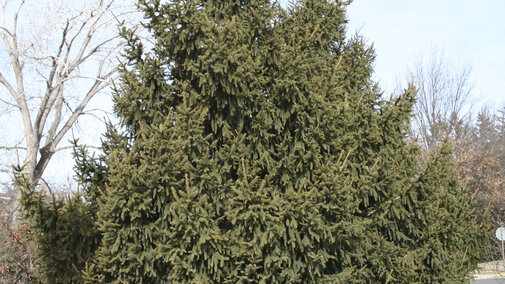Picea abies
,
Coniferous
Origin:
Europe
Norway spruce is a large pyramidal evergreen conifer native to the mountains of northern and central Europe (including Norway). It has
been used extensively as a landscape tree in eastern Nebraska where it’s distinguished by its large size and its pendulous, droopy
branches.

Where To Grow
Norway Spruce is perhaps the best adapted spruce for eastern Nebraska and is one of the most commonly planted spruces throughout the
upper Midwest and New England. It’s easily grown in average, acidic, evenly moist, well-drained soils in full sun, but will tolerate a
fairly wide range of conditions. Although it prefers cool summer climates, it is well adapted to the eastern Great Plains. Norway
spruce is more tolerant of urban conditions than other spruces and is the best spruce for irrigated landscapes. It is not as drought
tolerant as other spruces. Norway spruce grows quite tall and wide so it should be given more room than other evergreens.
Suitable to plant east of the 100th meridian.
Size at Maturity
Tree Height
Tree Spread
40-75'
30-50'
Wildlife Benefits
Similar to other spruces, Norway spruces sustains a wide variety of wildlife, especially birds.
Utilization
It is an important timber tree in its native Europe.
Additional Considerations
In eastern Nebraska, Norway spruce tends to have few insect and disease problems. Bagworms are perhaps the biggest concern. Although
Norway spruce can tolerate normal dry periods, it is one of the least drought tolerant spruces for our region.
Related species
Serbian Spruce (Picea omorika), native to eastern Europe including Serbia and Bosnia, is a graceful tree with
pendulous branches and attractive two-toned needles that give it a silvery cast. It prefers protected planting locations in Nebraska
and can grow up to 45’x 20’.
Oriental Spruce (Picea orientalis) is a dense, conical evergreen native to the Caucasus. It is best known for
its very stout but short needles; needs protection in Nebraska; grows 45’x 20’.
Interesting Facts
The genus name Picea is reportedly derived from the Latin word pix meaning pitch in reference to the sticky resin
typically found in spruce bark. The species name abies refers to its similarity to the genus Abies (fir species).
The tree is the source of spruce beer, which was once used to prevent and even cure scurvy in Europe. Norway spruce is prized
as a source of tonewood by stringed-instrument makers and was used by Stradivarius for his instruments.